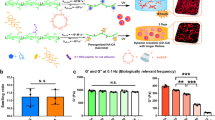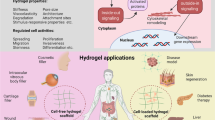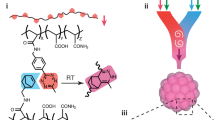Abstract
Material–biology interfaces are elemental in disease diagnosis and treatment. While monolithic biointerfaces are easier to implement, distributed and focal interfaces tend to be more dynamic and less invasive. Here, using naturally occurring precursors, we constructed a granule-releasing hydrogel platform that shows monolithic-to-focal evolving biointerfaces, thus expanding the forms, delivery methods and application domains of traditional monolithic or focal biointerfaces. Individual granules were embedded in a responsive hydrogel matrix and then converted into various macroscopic shapes such as bandages and bioelectronics–gel hybrids to enhance macroscopic manipulation. The granules can be released from the macroscopic shapes and establish focal bio-adhesions ex vivo and in vivo, for which molecular dynamics simulations reveal the adhesion mechanism. With the evolving design, we demonstrate that granule-releasing hydrogels effectively treat ulcerative colitis, heal skin wounds and reduce myocardial infarctions. Furthermore, we demonstrate improved device manipulation and bio-adhesion when granule-releasing hydrogels are incorporated into flexible cardiac electrophysiology mapping devices. This work presents an approach for building dynamic biointerfaces.

This is a preview of subscription content, access via your institution
Access options
Subscribe to this journal
Receive 12 digital issues and online access to articles
118,99 € per year
only 9,92 € per issue
Buy this article
- Purchase on SpringerLink
- Instant access to full article PDF
Prices may be subject to local taxes which are calculated during checkout






Similar content being viewed by others
Data availability
All data supporting the findings of this study are available within the article and its Supplementary Information. Data are also available from the corresponding authors upon reasonable request. Source data are provided with this paper. All Source Data are also available at https://osf.io/tns4k/?view_only=2bac0651e0f84f62acd95d490c773c31.
Code availability
Custom code used in this study is available at https://github.com/sjiuyun/Code-Availability.
References
Elnathan, R. et al. Biointerface design for vertical nanoprobes. Nat. Rev. Mater. https://doi.org/10.1038/s41578-022-00464-7 (2022).
Zhang, S. F. et al. An inflammation-targeting hydrogel for local drug delivery in inflammatory bowel disease. Sci. Transl. Med. https://doi.org/10.1126/scitranslmed.aaa5657 (2015).
Nan, K. et al. Mucosa-interfacing electronics. Nat. Rev. Mater. https://doi.org/10.1038/s41578-022-00477-2 (2022).
Jiang, Y. W. et al. Topological supramolecular network enabled high-conductivity, stretchable organic bioelectronics. Science 375, 1411–1417 (2022).
Wang, X. et al. A nanofibrous encapsulation device for safe delivery of insulin-producing cells to treat type 1 diabetes. Sci. Transl. Med. https://doi.org/10.1126/scitranslmed.abb4601 (2021).
Armstrong, J. P. K. et al. A blueprint for translational regenerative medicine. Sci. Transl. Med. https://doi.org/10.1126/scitranslmed.aaz2253 (2020).
Yang, Q. S. et al. Photocurable bioresorbable adhesives as functional interfaces between flexible bioelectronic devices and soft biological tissues. Nat. Mater. 20, 1559–1570 (2021).
Kim, D. H. et al. Epidermal electronics. Science 333, 838–843 (2011).
Yang, Y. Y. et al. Wireless multilateral devices for optogenetic studies of individual and social behaviors. Nat. Neurosci. 24, 1035–1045 (2021).
Freedman, B. R. et al. Enhanced tendon healing by a tough hydrogel with an adhesive side and high drug-loading capacity. Nat. Biomed. Eng. https://doi.org/10.1038/s41551-021-00810-0 (2022).
Deng, J. et al. Electrical bioadhesive interface for bioelectronics. Nat. Mater. 20, 229–236 (2021).
Tringides, C. M. et al. Viscoelastic surface electrode arrays to interface with viscoelastic tissues. Nat. Nanotechnol. 16, 1019–1029 (2021).
Lin, X. et al. A viscoelastic adhesive epicardial patch for treating myocardial infarction. Nat. Biomed. Eng. 3, 632–643 (2019).
Brannon, E. R. et al. Polymeric particle-based therapies for acute inflammatory diseases. Nat. Rev. Mater. 7, 796–813 (2022).
Lueckgen, A. et al. Enzymatically-degradable alginate hydrogels promote cell spreading and in vivo tissue infiltration. Biomaterials https://doi.org/10.1016/j.biomaterials.2019.119294 (2019).
Griffin, D. R., Weaver, W. M., Scumpia, P. O., Di Carlo, D. & Segura, T. Accelerated wound healing by injectable microporous gel scaffolds assembled from annealed building blocks. Nat. Mater. 14, 737–744 (2015).
Chen, J. et al. Pollen-inspired enzymatic microparticles to reduce organophosphate toxicity in managed pollinators. Nat. Food 2, 339–347 (2021).
Tang, J. A. et al. Therapeutic microparticles functionalized with biomimetic cardiac stem cell membranes and secretome. Nat. Commun. 8, 13724 (2017).
Gattazzo, F., Urciuolo, A. & Bonaldo, P. Extracellular matrix: a dynamic microenvironment for stem cell niche. Biochim. Biophys. Acta 1840, 2506–2519 (2014).
Koo, J. et al. Wireless bioresorbable electronic system enables sustained nonpharmacological neuroregenerative therapy. Nat. Med. 24, 1830–1836 (2018).
Allen, M. E., Hindley, J. W., Baxani, D. K., Ces, O. & Elan, Y. Hydrogels as functional components in artificial cell systems. Nat. Rev. Chem. 6, 562–578 (2022).
Daly, A. C., Riley, L., Segura, T. & Burdick, J. A. Hydrogel microparticles for biomedical applications. Nat. Rev. Mater. 5, 20–43 (2020).
Xu, Y. X., Kim, K. M., Hanna, M. A. & Nag, D. Chitosan-starch composite film: preparation and characterization. Ind. Crop Prod. 21, 185–192 (2005).
Masina, N. et al. A review of the chemical modification techniques of starch. Carbohyd. Polym. 157, 1226–1236 (2017).
Li, J. X. et al. A tissue-like neurotransmitter sensor for the brain and gut. Nature 606, 94–101 (2022).
Guimaraes, C. F., Gasperini, L., Marques, A. P. & Reis, R. L. The stiffness of living tissues and its implications for tissue engineering. Nat. Rev. Mater. 5, 351–370 (2020).
Fang, Y. et al. Dynamic and programmable cellular-scale granules enable tissue-like materials. Matter 2, 948–964 (2020).
Park, B. et al. Cuticular pad-inspired selective frequency damper for nearly dynamic noise-free bioelectronics. Science 376, 624–629 (2022).
Du, H. L., Liu, M. R., Yang, X. Y. & Zhai, G. X. The design of pH-sensitive chitosan-based formulations for gastrointestinal delivery. Drug Discov. Today 20, 1004–1011 (2015).
Dabrowska, M., Starek, M. & Skucinski, J. Lipophilicity study of some non-steroidal anti-inflammatory agents and cephalosporin antibiotics: a review. Talanta 86, 35–51 (2011).
Galie, P. A. et al. Fluid shear stress threshold regulates angiogenic sprouting. Proc. Natl Acad. Sci. USA 111, 7968–7973 (2014).
Kobayashi, T. et al. Ulcerative colitis. Nat. Rev. Dis. Primers 6, 74 (2020).
Jeong, D. Y. et al. Induction and maintenance treatment of inflammatory bowel disease: a comprehensive review. Autoimmun. Rev. 18, 439–454 (2019).
Chassaing, B., Aitken, J. D., Malleshappa, M. & Vijay-Kumar, M. Dextran sulfate sodium (DSS)-induced colitis in mice. Curr. Protoc. Immunol. 104, 15.25.11–15.25.14 (2014).
Diao, Y. J. et al. Effect of interactions between starch and chitosan on waxy maize starch physicochemical and digestion properties. CyTA J. Food 15, 327–335 (2017).
Cao, Y. P. & Mezzenga, R. Design principles of food gels. Nat. Food 1, 106–118 (2020).
Ni, J., Wu, G. D., Albenberg, L. & Tomov, V. T. Gut microbiota and IBD: causation or correlation? Nat. Rev. Gastroenterol. Hepatol. 14, 573–584 (2017).
Round, J. L. & Mazmanian, S. K. The gut microbiota shapes intestinal immune responses during health and disease. Nat. Rev. Immunol. 9, 313–323 (2009).
Fabia, R. et al. Impairment of bacterial-flora in human ulcerative-colitis and experimental colitis in the rat. Digestion 54, 248–255 (1993).
Zhang, Z. et al. Chlorogenic acid ameliorates experimental colitis by promoting growth of akkermansia in mice. Nutrients https://doi.org/10.3390/nu9070677 (2017).
Osman, N., Adawi, D., Ahrne, S., Jeppsson, B. & Molin, G. Modulation of the effect of dextran sulfate sodium-induced acute colitis by the administration of different probiotic strains of Lactobacillus and Bifidobacterium. Digest. Dis. Sci. 49, 320–327 (2004).
Geier, M. S., Butler, R. N., Giffard, P. M. & Howarth, G. S. Lactobacillus fermentum BR11, a potential new probiotic, alleviates symptoms of colitis induced by dextran sulfate sodium (DSS) in rats. Int. J. Food Microbiol. 114, 267–274 (2007).
Sostres, C. & Lanas, A. Gastrointestinal effects of aspirin. Nat. Rev. Gastroenterol. Hepatol. 8, 385–394 (2011).
Zhang, W. et al. Catechol-functionalized hydrogels: biomimetic design, adhesion mechanism, and biomedical applications. Chem. Soc. Rev. 49, 433–464 (2020).
Griffin, D. R. et al. Activating an adaptive immune response from a hydrogel scaffold imparts regenerative wound healing. Nat. Mater. 20, 560–569 (2021).
Gurtner, G. C., Werner, S., Barrandon, Y. & Longaker, M. T. Wound repair and regeneration. Nature 453, 314–321 (2008).
Park, J. et al. Electromechanical cardioplasty using a wrapped elasto-conductive epicardial mesh. Sci. Transl. Med. https://doi.org/10.1126/scitranslmed.aad8568 (2016).
Thygesen, K. et al. Third universal definition of myocardial infarction. Nat. Rev. Cardiol. 9, 620–633 (2012).
Acknowledgements
We thank K. Watters for scientific editing of the paper. B.T. acknowledges support from the US Air Force Office of Scientific Research (FA9550-20-1-0387), the National Science Foundation (NSF MPS-2121044) and the US Army Research Office (W911NF-21-1-0090). B.T. and J.Y. acknowledge support from the GI research foundation. P.K. acknowledges support from the National Science Foundation (DMR 2212123). Use of the Advanced Photon Source and the Center for Nanoscale Materials, both US Department of Energy Office of Science User Facilities, was supported by the US Department of Energy, Office of Science, under contract no. DE-AC02-06CH11357. H.-M.T. acknowledges the support from the Integrated Small Animal Imaging Research Resource (iSAIRR) at the University of Chicago. Parts of this work were carried out at the Soft Matter Characterization Facility of the University of Chicago. Parts of the diagrams in Fig. 1f and Fig. 4b were created with BioRender.com. We thank A. Tokmakoff and X.-x. Zhang for their support and helpful discussions.
Author information
Authors and Affiliations
Contributions
B.T., J.Y., P.K. and E.B.C. supervised the research. J.S., J.Y. and B.T. conceived the idea. J.S., Y. Lin, J.Y. and B.T. developed the methods. J.S., Y. Lin, P.L., C.S., K.P., S.K., B.A., L.M., Y. Luo, S.C., H.-M.T., C.M.C., J.Z., Z.C., J.A.A.-H., J.C. and J.Y. performed the experiments. P.M. and P.K. performed the simulation. J.M., Y. Luo, S.C., H.-M.T. and P.G. analyzed and processed the data. J.S., Y. Lin, J.Y. and B.T. wrote the paper with comments from all authors.
Corresponding authors
Ethics declarations
Competing interests
The authors declare no competing interests.
Peer review
Peer review information
Nature Chemical Engineering thanks Eric Appel, Youn Soo Kim and the other, anonymous, reviewer(s) for their contribution to the peer review of this work.
Additional information
Publisher’s note Springer Nature remains neutral with regard to jurisdictional claims in published maps and institutional affiliations.
Supplementary information
Supplementary Information
Supplementary Materials and Methods, Tables 1–3 and Figs. 1–67.
Source data
Source Data Fig. 2
Statistical source data.
Source Data Fig. 3
Statistical source data.
Source Data Fig. 4
Statistical source data.
Source Data Fig. 5
Statistical source data.
Source Data Fig. 6
Statistical source data.
Rights and permissions
Springer Nature or its licensor (e.g. a society or other partner) holds exclusive rights to this article under a publishing agreement with the author(s) or other rightsholder(s); author self-archiving of the accepted manuscript version of this article is solely governed by the terms of such publishing agreement and applicable law.
About this article
Cite this article
Shi, J., Lin, Y., Li, P. et al. Monolithic-to-focal evolving biointerfaces in tissue regeneration and bioelectronics. Nat Chem Eng 1, 73–86 (2024). https://doi.org/10.1038/s44286-023-00008-y
Received:
Accepted:
Published:
Issue Date:
DOI: https://doi.org/10.1038/s44286-023-00008-y
This article is cited by
-
Implantable bioelectronic devices for photoelectrochemical and electrochemical modulation of cells and tissues
Nature Reviews Bioengineering (2025)
-
Boosting hydrogel conductivity via water-dispersible conducting polymers for injectable bioelectronics
Nature Communications (2025)
-
Materials and device strategies to enhance spatiotemporal resolution in bioelectronics
Nature Reviews Materials (2025)
-
Neutrophil extracellular traps-inspired DNA hydrogel for wound hemostatic adjuvant
Nature Communications (2024)
-
Sticky gels designed for tissue-healing therapies and diagnostics
Nature (2024)



